Strategic Marketing MKTG 606: An Essay on Brand Equity and its Impact
VerifiedAdded on 2023/06/12
|13
|3643
|194
Essay
AI Summary
This essay provides a comprehensive analysis of brand equity within the context of strategic marketing management. It begins by defining strategic marketing and highlighting the importance of competitive advantage. The essay then delves into the concept of brand equity, tracing its history back to the mid-1980s and examining the contributions of key scholars like David Aaker and Kevin Lane Keller. Aaker's model, which focuses on brand awareness, perceived quality, brand associations, and brand loyalty, is discussed, as is Keller's consumer-based perspective on brand knowledge and brand image. The essay also connects brand equity to Michael Porter's Five Forces analysis, emphasizing the importance of understanding consumer bargaining power, competitive rivalry, and the threat of new entrants. It concludes by underscoring the role of brand equity in improving consumer preference and purchasing patterns and its integration with other strategic marketing concepts like the marketing mix and marketing strategy.
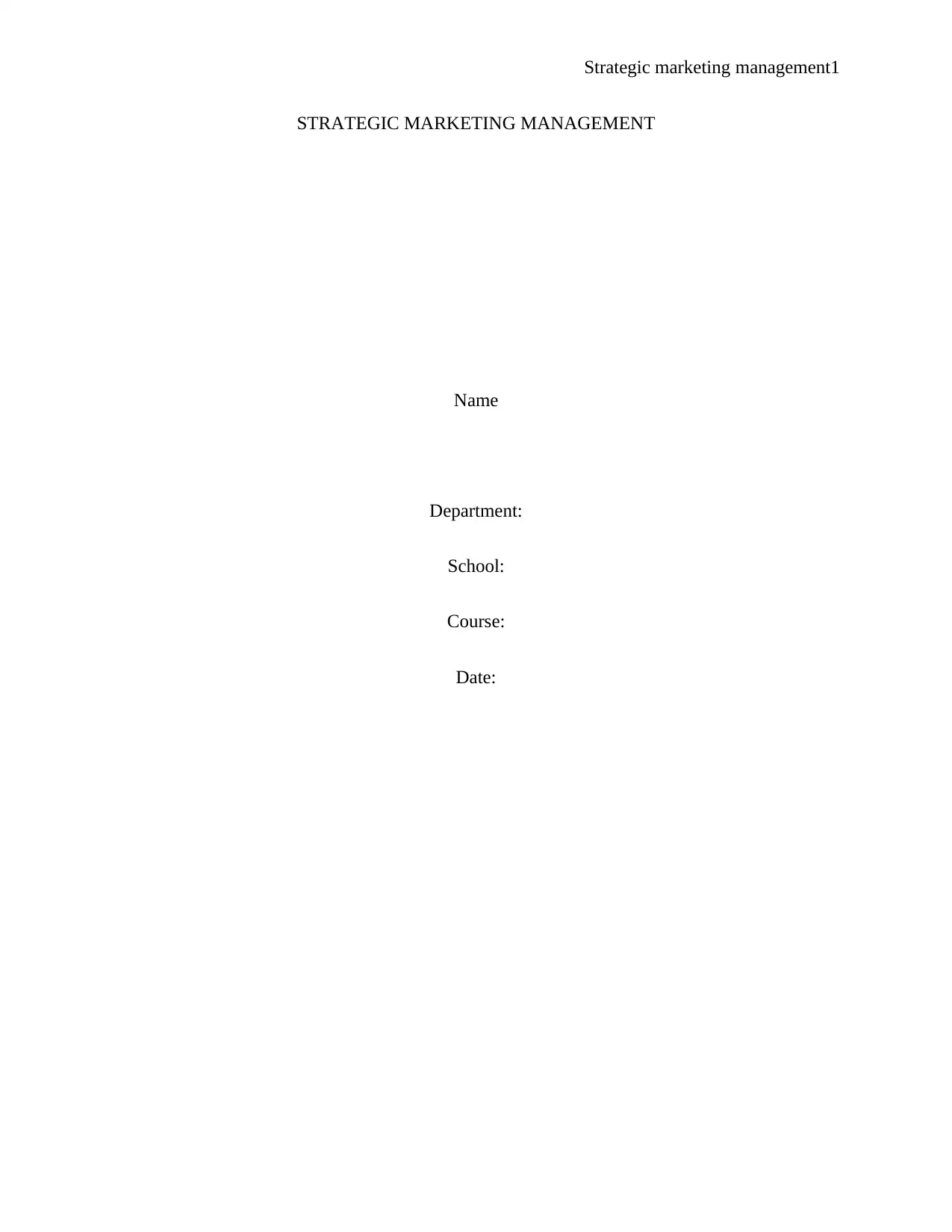
Strategic marketing management1
STRATEGIC MARKETING MANAGEMENT
Name
Department:
School:
Course:
Date:
STRATEGIC MARKETING MANAGEMENT
Name
Department:
School:
Course:
Date:
Paraphrase This Document
Need a fresh take? Get an instant paraphrase of this document with our AI Paraphraser
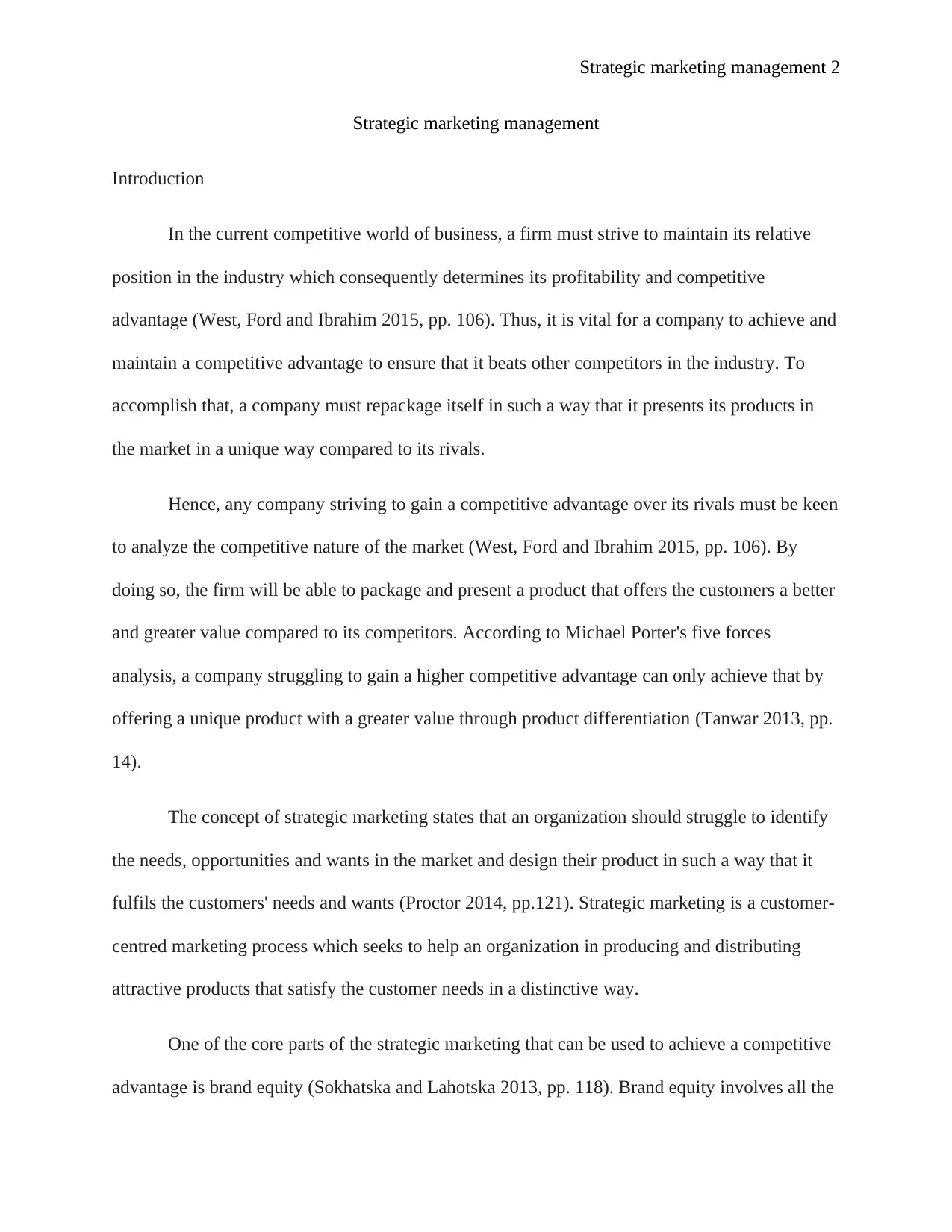
Strategic marketing management 2
Strategic marketing management
Introduction
In the current competitive world of business, a firm must strive to maintain its relative
position in the industry which consequently determines its profitability and competitive
advantage (West, Ford and Ibrahim 2015, pp. 106). Thus, it is vital for a company to achieve and
maintain a competitive advantage to ensure that it beats other competitors in the industry. To
accomplish that, a company must repackage itself in such a way that it presents its products in
the market in a unique way compared to its rivals.
Hence, any company striving to gain a competitive advantage over its rivals must be keen
to analyze the competitive nature of the market (West, Ford and Ibrahim 2015, pp. 106). By
doing so, the firm will be able to package and present a product that offers the customers a better
and greater value compared to its competitors. According to Michael Porter's five forces
analysis, a company struggling to gain a higher competitive advantage can only achieve that by
offering a unique product with a greater value through product differentiation (Tanwar 2013, pp.
14).
The concept of strategic marketing states that an organization should struggle to identify
the needs, opportunities and wants in the market and design their product in such a way that it
fulfils the customers' needs and wants (Proctor 2014, pp.121). Strategic marketing is a customer-
centred marketing process which seeks to help an organization in producing and distributing
attractive products that satisfy the customer needs in a distinctive way.
One of the core parts of the strategic marketing that can be used to achieve a competitive
advantage is brand equity (Sokhatska and Lahotska 2013, pp. 118). Brand equity involves all the
Strategic marketing management
Introduction
In the current competitive world of business, a firm must strive to maintain its relative
position in the industry which consequently determines its profitability and competitive
advantage (West, Ford and Ibrahim 2015, pp. 106). Thus, it is vital for a company to achieve and
maintain a competitive advantage to ensure that it beats other competitors in the industry. To
accomplish that, a company must repackage itself in such a way that it presents its products in
the market in a unique way compared to its rivals.
Hence, any company striving to gain a competitive advantage over its rivals must be keen
to analyze the competitive nature of the market (West, Ford and Ibrahim 2015, pp. 106). By
doing so, the firm will be able to package and present a product that offers the customers a better
and greater value compared to its competitors. According to Michael Porter's five forces
analysis, a company struggling to gain a higher competitive advantage can only achieve that by
offering a unique product with a greater value through product differentiation (Tanwar 2013, pp.
14).
The concept of strategic marketing states that an organization should struggle to identify
the needs, opportunities and wants in the market and design their product in such a way that it
fulfils the customers' needs and wants (Proctor 2014, pp.121). Strategic marketing is a customer-
centred marketing process which seeks to help an organization in producing and distributing
attractive products that satisfy the customer needs in a distinctive way.
One of the core parts of the strategic marketing that can be used to achieve a competitive
advantage is brand equity (Sokhatska and Lahotska 2013, pp. 118). Brand equity involves all the
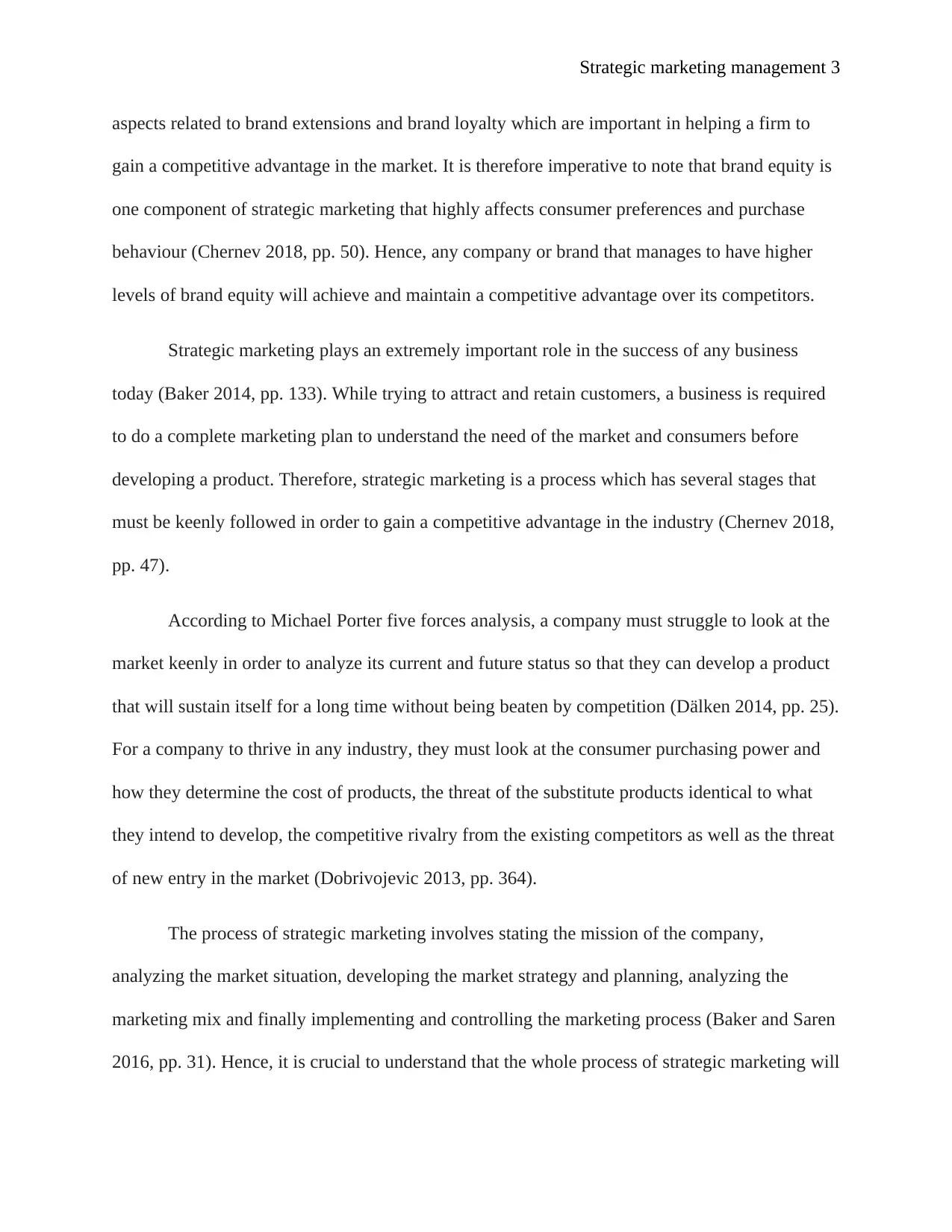
Strategic marketing management 3
aspects related to brand extensions and brand loyalty which are important in helping a firm to
gain a competitive advantage in the market. It is therefore imperative to note that brand equity is
one component of strategic marketing that highly affects consumer preferences and purchase
behaviour (Chernev 2018, pp. 50). Hence, any company or brand that manages to have higher
levels of brand equity will achieve and maintain a competitive advantage over its competitors.
Strategic marketing plays an extremely important role in the success of any business
today (Baker 2014, pp. 133). While trying to attract and retain customers, a business is required
to do a complete marketing plan to understand the need of the market and consumers before
developing a product. Therefore, strategic marketing is a process which has several stages that
must be keenly followed in order to gain a competitive advantage in the industry (Chernev 2018,
pp. 47).
According to Michael Porter five forces analysis, a company must struggle to look at the
market keenly in order to analyze its current and future status so that they can develop a product
that will sustain itself for a long time without being beaten by competition (Dälken 2014, pp. 25).
For a company to thrive in any industry, they must look at the consumer purchasing power and
how they determine the cost of products, the threat of the substitute products identical to what
they intend to develop, the competitive rivalry from the existing competitors as well as the threat
of new entry in the market (Dobrivojevic 2013, pp. 364).
The process of strategic marketing involves stating the mission of the company,
analyzing the market situation, developing the market strategy and planning, analyzing the
marketing mix and finally implementing and controlling the marketing process (Baker and Saren
2016, pp. 31). Hence, it is crucial to understand that the whole process of strategic marketing will
aspects related to brand extensions and brand loyalty which are important in helping a firm to
gain a competitive advantage in the market. It is therefore imperative to note that brand equity is
one component of strategic marketing that highly affects consumer preferences and purchase
behaviour (Chernev 2018, pp. 50). Hence, any company or brand that manages to have higher
levels of brand equity will achieve and maintain a competitive advantage over its competitors.
Strategic marketing plays an extremely important role in the success of any business
today (Baker 2014, pp. 133). While trying to attract and retain customers, a business is required
to do a complete marketing plan to understand the need of the market and consumers before
developing a product. Therefore, strategic marketing is a process which has several stages that
must be keenly followed in order to gain a competitive advantage in the industry (Chernev 2018,
pp. 47).
According to Michael Porter five forces analysis, a company must struggle to look at the
market keenly in order to analyze its current and future status so that they can develop a product
that will sustain itself for a long time without being beaten by competition (Dälken 2014, pp. 25).
For a company to thrive in any industry, they must look at the consumer purchasing power and
how they determine the cost of products, the threat of the substitute products identical to what
they intend to develop, the competitive rivalry from the existing competitors as well as the threat
of new entry in the market (Dobrivojevic 2013, pp. 364).
The process of strategic marketing involves stating the mission of the company,
analyzing the market situation, developing the market strategy and planning, analyzing the
marketing mix and finally implementing and controlling the marketing process (Baker and Saren
2016, pp. 31). Hence, it is crucial to understand that the whole process of strategic marketing will
⊘ This is a preview!⊘
Do you want full access?
Subscribe today to unlock all pages.

Trusted by 1+ million students worldwide
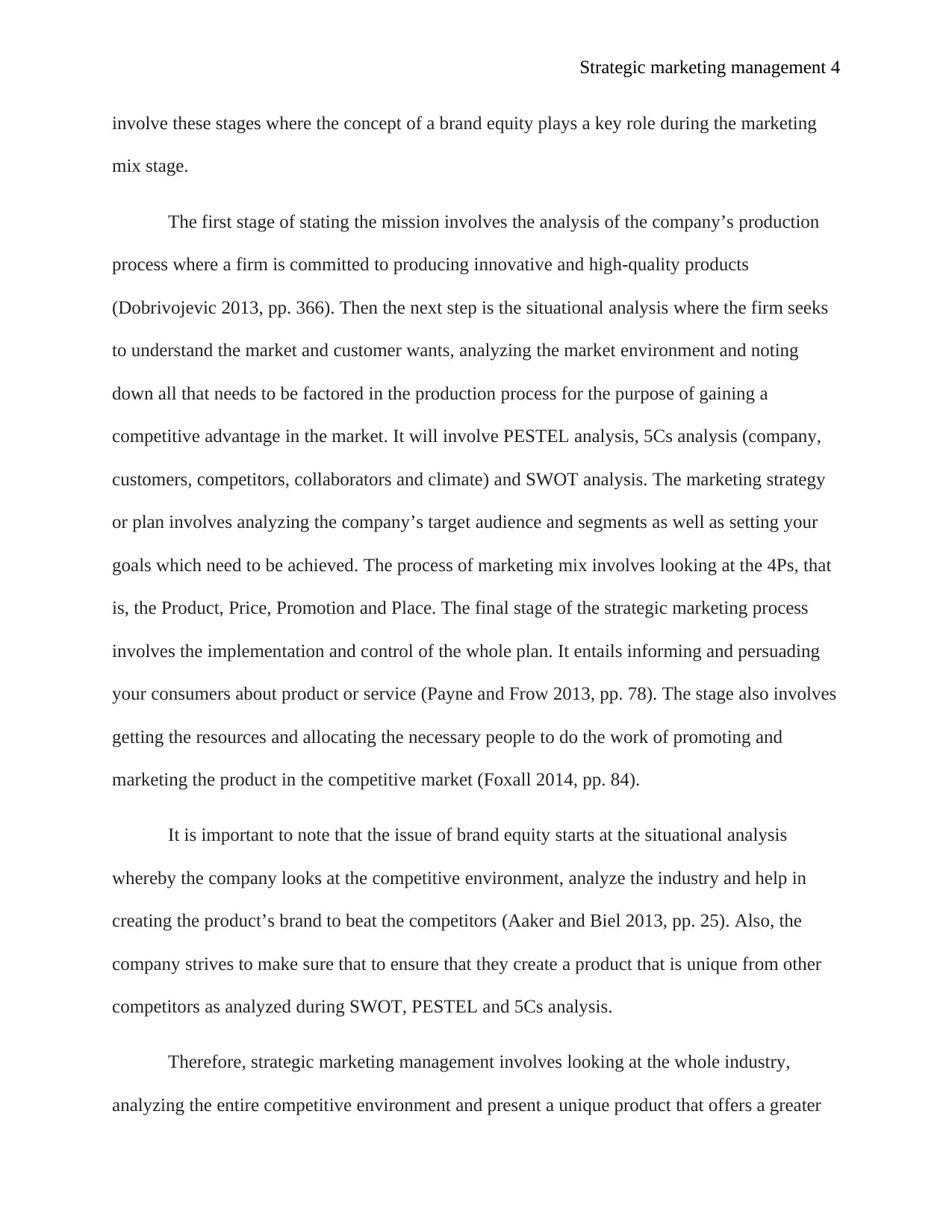
Strategic marketing management 4
involve these stages where the concept of a brand equity plays a key role during the marketing
mix stage.
The first stage of stating the mission involves the analysis of the company’s production
process where a firm is committed to producing innovative and high-quality products
(Dobrivojevic 2013, pp. 366). Then the next step is the situational analysis where the firm seeks
to understand the market and customer wants, analyzing the market environment and noting
down all that needs to be factored in the production process for the purpose of gaining a
competitive advantage in the market. It will involve PESTEL analysis, 5Cs analysis (company,
customers, competitors, collaborators and climate) and SWOT analysis. The marketing strategy
or plan involves analyzing the company’s target audience and segments as well as setting your
goals which need to be achieved. The process of marketing mix involves looking at the 4Ps, that
is, the Product, Price, Promotion and Place. The final stage of the strategic marketing process
involves the implementation and control of the whole plan. It entails informing and persuading
your consumers about product or service (Payne and Frow 2013, pp. 78). The stage also involves
getting the resources and allocating the necessary people to do the work of promoting and
marketing the product in the competitive market (Foxall 2014, pp. 84).
It is important to note that the issue of brand equity starts at the situational analysis
whereby the company looks at the competitive environment, analyze the industry and help in
creating the product’s brand to beat the competitors (Aaker and Biel 2013, pp. 25). Also, the
company strives to make sure that to ensure that they create a product that is unique from other
competitors as analyzed during SWOT, PESTEL and 5Cs analysis.
Therefore, strategic marketing management involves looking at the whole industry,
analyzing the entire competitive environment and present a unique product that offers a greater
involve these stages where the concept of a brand equity plays a key role during the marketing
mix stage.
The first stage of stating the mission involves the analysis of the company’s production
process where a firm is committed to producing innovative and high-quality products
(Dobrivojevic 2013, pp. 366). Then the next step is the situational analysis where the firm seeks
to understand the market and customer wants, analyzing the market environment and noting
down all that needs to be factored in the production process for the purpose of gaining a
competitive advantage in the market. It will involve PESTEL analysis, 5Cs analysis (company,
customers, competitors, collaborators and climate) and SWOT analysis. The marketing strategy
or plan involves analyzing the company’s target audience and segments as well as setting your
goals which need to be achieved. The process of marketing mix involves looking at the 4Ps, that
is, the Product, Price, Promotion and Place. The final stage of the strategic marketing process
involves the implementation and control of the whole plan. It entails informing and persuading
your consumers about product or service (Payne and Frow 2013, pp. 78). The stage also involves
getting the resources and allocating the necessary people to do the work of promoting and
marketing the product in the competitive market (Foxall 2014, pp. 84).
It is important to note that the issue of brand equity starts at the situational analysis
whereby the company looks at the competitive environment, analyze the industry and help in
creating the product’s brand to beat the competitors (Aaker and Biel 2013, pp. 25). Also, the
company strives to make sure that to ensure that they create a product that is unique from other
competitors as analyzed during SWOT, PESTEL and 5Cs analysis.
Therefore, strategic marketing management involves looking at the whole industry,
analyzing the entire competitive environment and present a unique product that offers a greater
Paraphrase This Document
Need a fresh take? Get an instant paraphrase of this document with our AI Paraphraser
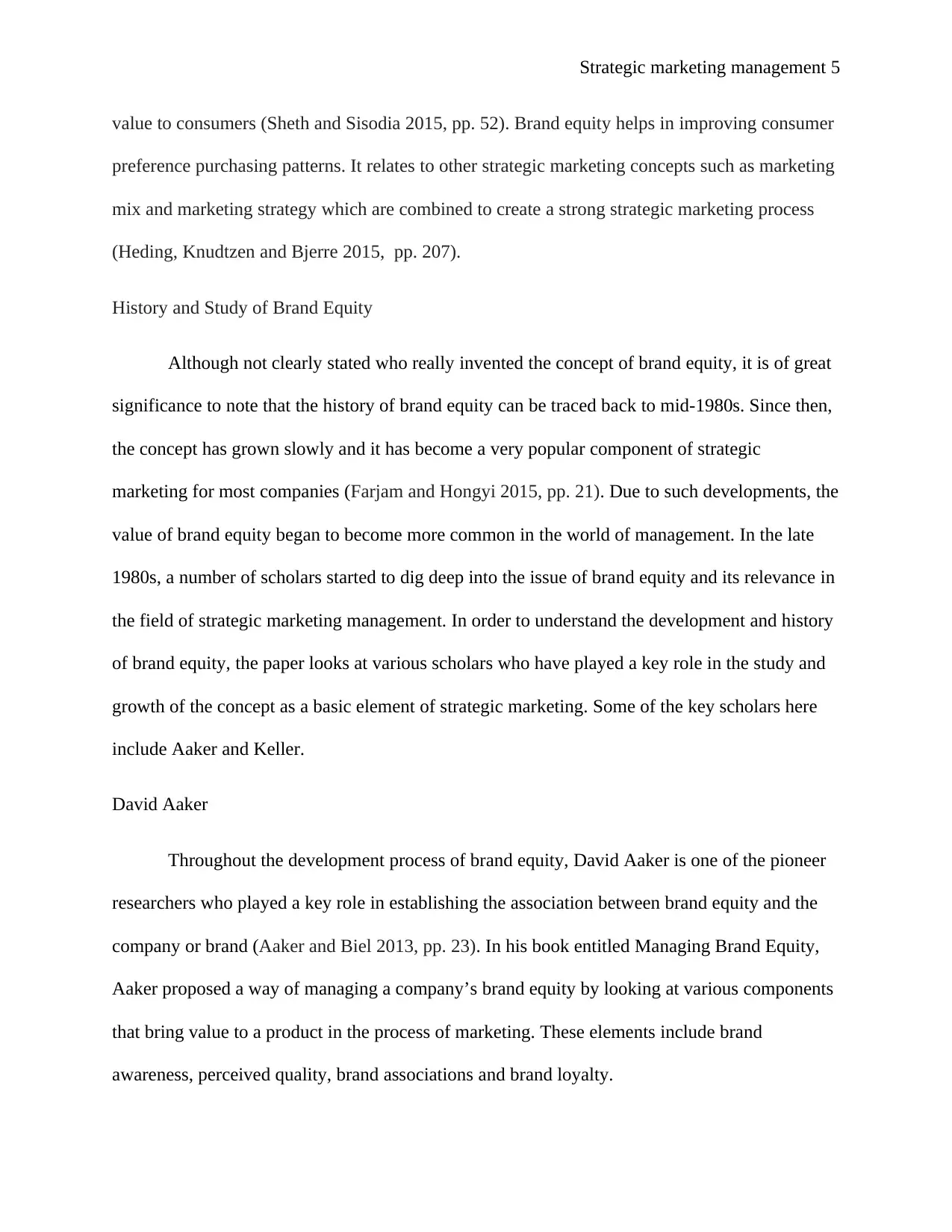
Strategic marketing management 5
value to consumers (Sheth and Sisodia 2015, pp. 52). Brand equity helps in improving consumer
preference purchasing patterns. It relates to other strategic marketing concepts such as marketing
mix and marketing strategy which are combined to create a strong strategic marketing process
(Heding, Knudtzen and Bjerre 2015, pp. 207).
History and Study of Brand Equity
Although not clearly stated who really invented the concept of brand equity, it is of great
significance to note that the history of brand equity can be traced back to mid-1980s. Since then,
the concept has grown slowly and it has become a very popular component of strategic
marketing for most companies (Farjam and Hongyi 2015, pp. 21). Due to such developments, the
value of brand equity began to become more common in the world of management. In the late
1980s, a number of scholars started to dig deep into the issue of brand equity and its relevance in
the field of strategic marketing management. In order to understand the development and history
of brand equity, the paper looks at various scholars who have played a key role in the study and
growth of the concept as a basic element of strategic marketing. Some of the key scholars here
include Aaker and Keller.
David Aaker
Throughout the development process of brand equity, David Aaker is one of the pioneer
researchers who played a key role in establishing the association between brand equity and the
company or brand (Aaker and Biel 2013, pp. 23). In his book entitled Managing Brand Equity,
Aaker proposed a way of managing a company’s brand equity by looking at various components
that bring value to a product in the process of marketing. These elements include brand
awareness, perceived quality, brand associations and brand loyalty.
value to consumers (Sheth and Sisodia 2015, pp. 52). Brand equity helps in improving consumer
preference purchasing patterns. It relates to other strategic marketing concepts such as marketing
mix and marketing strategy which are combined to create a strong strategic marketing process
(Heding, Knudtzen and Bjerre 2015, pp. 207).
History and Study of Brand Equity
Although not clearly stated who really invented the concept of brand equity, it is of great
significance to note that the history of brand equity can be traced back to mid-1980s. Since then,
the concept has grown slowly and it has become a very popular component of strategic
marketing for most companies (Farjam and Hongyi 2015, pp. 21). Due to such developments, the
value of brand equity began to become more common in the world of management. In the late
1980s, a number of scholars started to dig deep into the issue of brand equity and its relevance in
the field of strategic marketing management. In order to understand the development and history
of brand equity, the paper looks at various scholars who have played a key role in the study and
growth of the concept as a basic element of strategic marketing. Some of the key scholars here
include Aaker and Keller.
David Aaker
Throughout the development process of brand equity, David Aaker is one of the pioneer
researchers who played a key role in establishing the association between brand equity and the
company or brand (Aaker and Biel 2013, pp. 23). In his book entitled Managing Brand Equity,
Aaker proposed a way of managing a company’s brand equity by looking at various components
that bring value to a product in the process of marketing. These elements include brand
awareness, perceived quality, brand associations and brand loyalty.
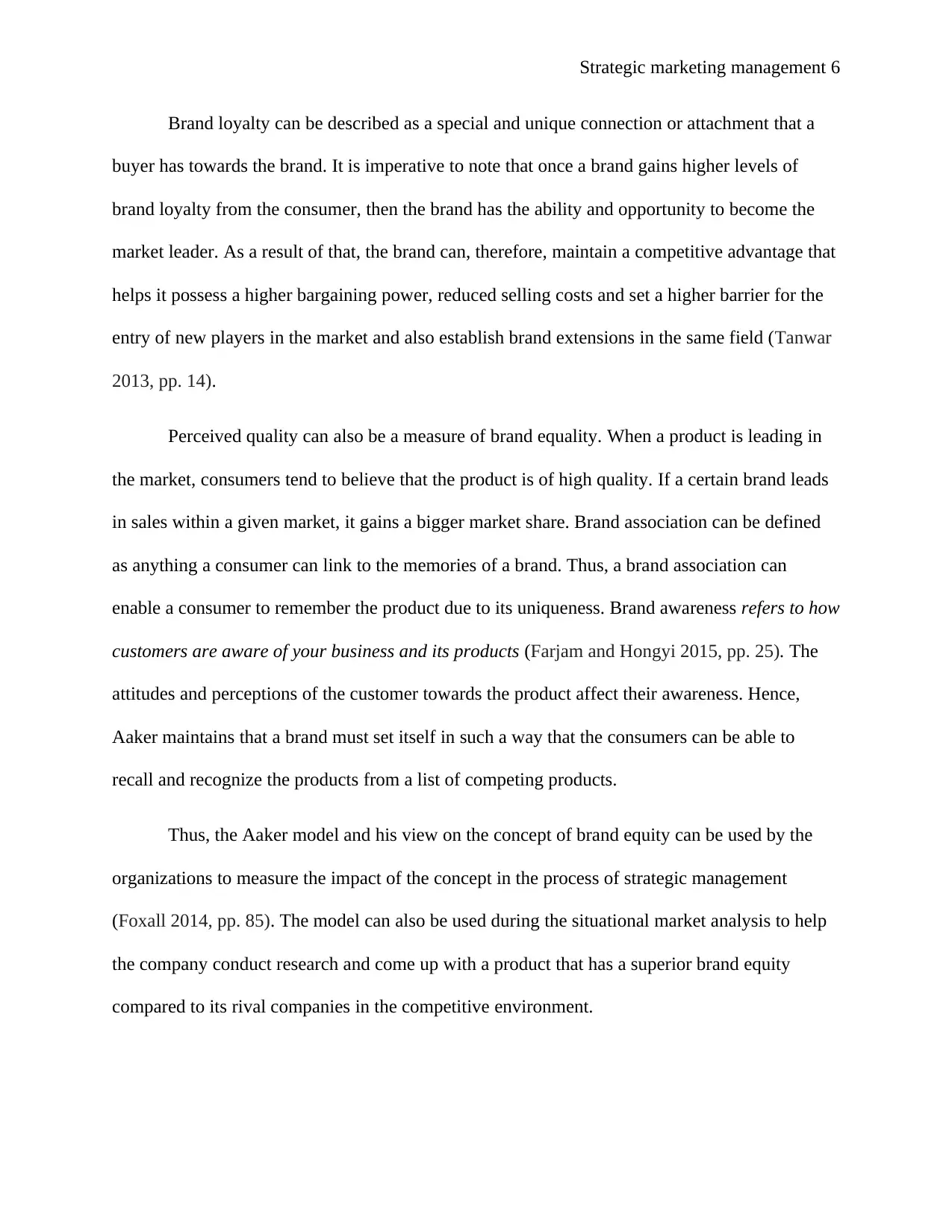
Strategic marketing management 6
Brand loyalty can be described as a special and unique connection or attachment that a
buyer has towards the brand. It is imperative to note that once a brand gains higher levels of
brand loyalty from the consumer, then the brand has the ability and opportunity to become the
market leader. As a result of that, the brand can, therefore, maintain a competitive advantage that
helps it possess a higher bargaining power, reduced selling costs and set a higher barrier for the
entry of new players in the market and also establish brand extensions in the same field (Tanwar
2013, pp. 14).
Perceived quality can also be a measure of brand equality. When a product is leading in
the market, consumers tend to believe that the product is of high quality. If a certain brand leads
in sales within a given market, it gains a bigger market share. Brand association can be defined
as anything a consumer can link to the memories of a brand. Thus, a brand association can
enable a consumer to remember the product due to its uniqueness. Brand awareness refers to how
customers are aware of your business and its products (Farjam and Hongyi 2015, pp. 25). The
attitudes and perceptions of the customer towards the product affect their awareness. Hence,
Aaker maintains that a brand must set itself in such a way that the consumers can be able to
recall and recognize the products from a list of competing products.
Thus, the Aaker model and his view on the concept of brand equity can be used by the
organizations to measure the impact of the concept in the process of strategic management
(Foxall 2014, pp. 85). The model can also be used during the situational market analysis to help
the company conduct research and come up with a product that has a superior brand equity
compared to its rival companies in the competitive environment.
Brand loyalty can be described as a special and unique connection or attachment that a
buyer has towards the brand. It is imperative to note that once a brand gains higher levels of
brand loyalty from the consumer, then the brand has the ability and opportunity to become the
market leader. As a result of that, the brand can, therefore, maintain a competitive advantage that
helps it possess a higher bargaining power, reduced selling costs and set a higher barrier for the
entry of new players in the market and also establish brand extensions in the same field (Tanwar
2013, pp. 14).
Perceived quality can also be a measure of brand equality. When a product is leading in
the market, consumers tend to believe that the product is of high quality. If a certain brand leads
in sales within a given market, it gains a bigger market share. Brand association can be defined
as anything a consumer can link to the memories of a brand. Thus, a brand association can
enable a consumer to remember the product due to its uniqueness. Brand awareness refers to how
customers are aware of your business and its products (Farjam and Hongyi 2015, pp. 25). The
attitudes and perceptions of the customer towards the product affect their awareness. Hence,
Aaker maintains that a brand must set itself in such a way that the consumers can be able to
recall and recognize the products from a list of competing products.
Thus, the Aaker model and his view on the concept of brand equity can be used by the
organizations to measure the impact of the concept in the process of strategic management
(Foxall 2014, pp. 85). The model can also be used during the situational market analysis to help
the company conduct research and come up with a product that has a superior brand equity
compared to its rival companies in the competitive environment.
⊘ This is a preview!⊘
Do you want full access?
Subscribe today to unlock all pages.

Trusted by 1+ million students worldwide
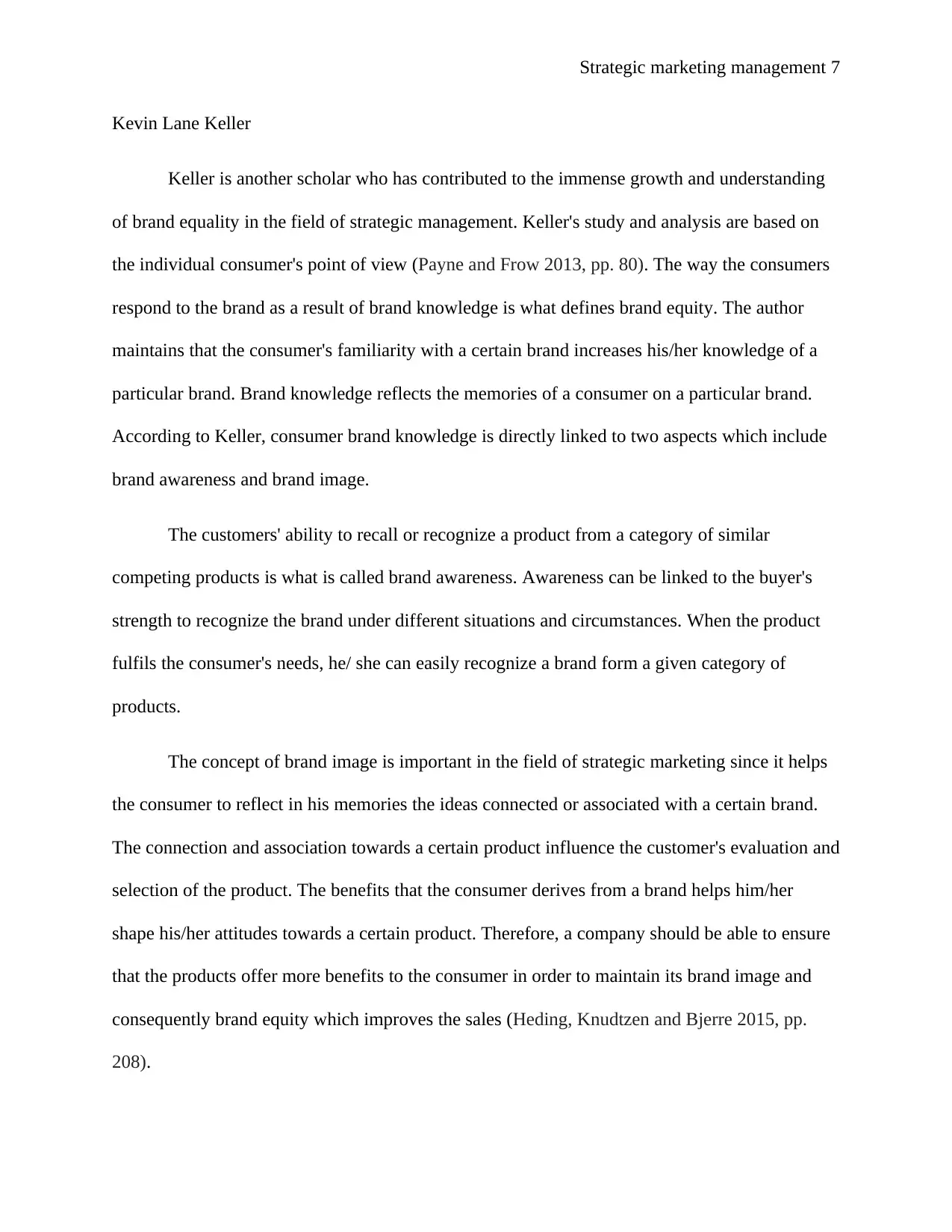
Strategic marketing management 7
Kevin Lane Keller
Keller is another scholar who has contributed to the immense growth and understanding
of brand equality in the field of strategic management. Keller's study and analysis are based on
the individual consumer's point of view (Payne and Frow 2013, pp. 80). The way the consumers
respond to the brand as a result of brand knowledge is what defines brand equity. The author
maintains that the consumer's familiarity with a certain brand increases his/her knowledge of a
particular brand. Brand knowledge reflects the memories of a consumer on a particular brand.
According to Keller, consumer brand knowledge is directly linked to two aspects which include
brand awareness and brand image.
The customers' ability to recall or recognize a product from a category of similar
competing products is what is called brand awareness. Awareness can be linked to the buyer's
strength to recognize the brand under different situations and circumstances. When the product
fulfils the consumer's needs, he/ she can easily recognize a brand form a given category of
products.
The concept of brand image is important in the field of strategic marketing since it helps
the consumer to reflect in his memories the ideas connected or associated with a certain brand.
The connection and association towards a certain product influence the customer's evaluation and
selection of the product. The benefits that the consumer derives from a brand helps him/her
shape his/her attitudes towards a certain product. Therefore, a company should be able to ensure
that the products offer more benefits to the consumer in order to maintain its brand image and
consequently brand equity which improves the sales (Heding, Knudtzen and Bjerre 2015, pp.
208).
Kevin Lane Keller
Keller is another scholar who has contributed to the immense growth and understanding
of brand equality in the field of strategic management. Keller's study and analysis are based on
the individual consumer's point of view (Payne and Frow 2013, pp. 80). The way the consumers
respond to the brand as a result of brand knowledge is what defines brand equity. The author
maintains that the consumer's familiarity with a certain brand increases his/her knowledge of a
particular brand. Brand knowledge reflects the memories of a consumer on a particular brand.
According to Keller, consumer brand knowledge is directly linked to two aspects which include
brand awareness and brand image.
The customers' ability to recall or recognize a product from a category of similar
competing products is what is called brand awareness. Awareness can be linked to the buyer's
strength to recognize the brand under different situations and circumstances. When the product
fulfils the consumer's needs, he/ she can easily recognize a brand form a given category of
products.
The concept of brand image is important in the field of strategic marketing since it helps
the consumer to reflect in his memories the ideas connected or associated with a certain brand.
The connection and association towards a certain product influence the customer's evaluation and
selection of the product. The benefits that the consumer derives from a brand helps him/her
shape his/her attitudes towards a certain product. Therefore, a company should be able to ensure
that the products offer more benefits to the consumer in order to maintain its brand image and
consequently brand equity which improves the sales (Heding, Knudtzen and Bjerre 2015, pp.
208).
Paraphrase This Document
Need a fresh take? Get an instant paraphrase of this document with our AI Paraphraser
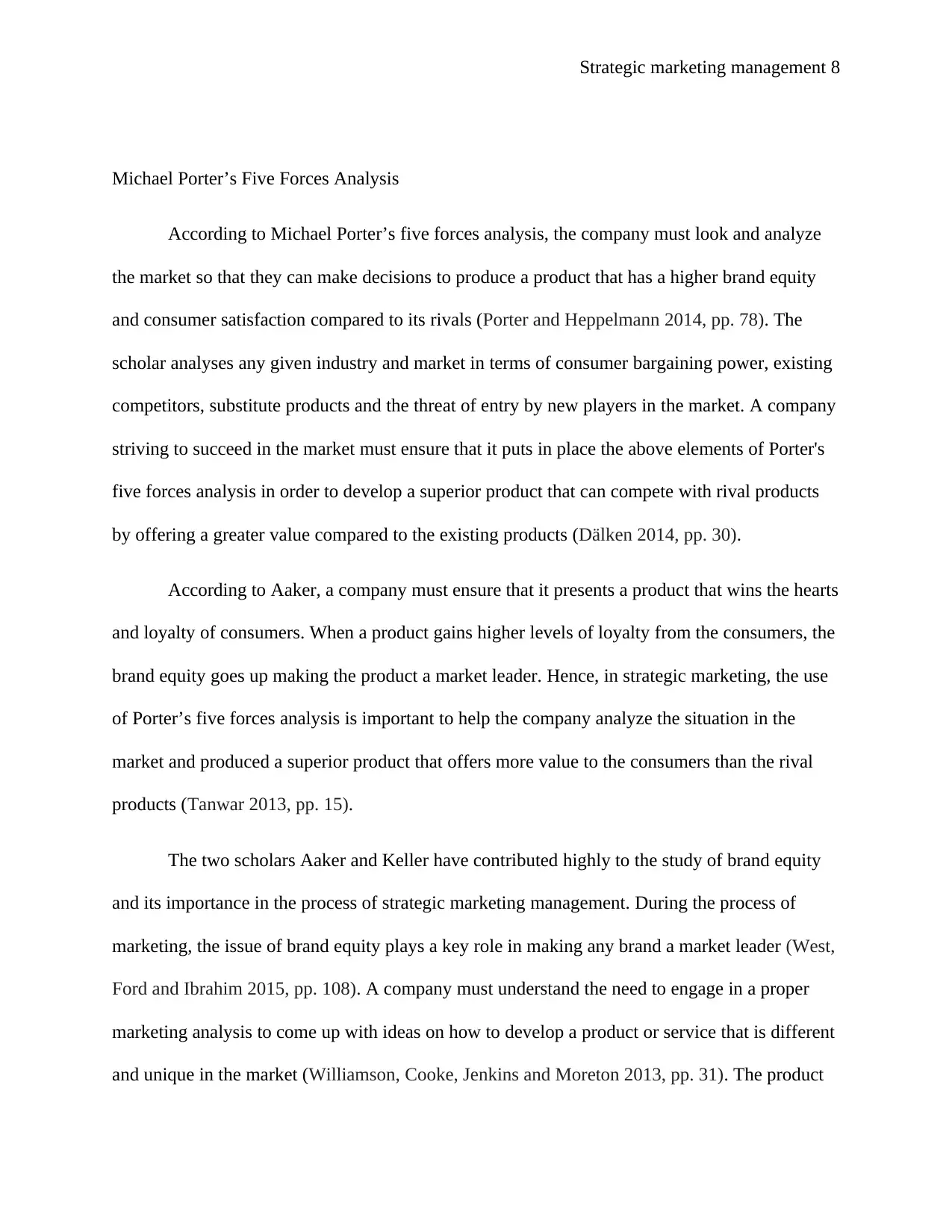
Strategic marketing management 8
Michael Porter’s Five Forces Analysis
According to Michael Porter’s five forces analysis, the company must look and analyze
the market so that they can make decisions to produce a product that has a higher brand equity
and consumer satisfaction compared to its rivals (Porter and Heppelmann 2014, pp. 78). The
scholar analyses any given industry and market in terms of consumer bargaining power, existing
competitors, substitute products and the threat of entry by new players in the market. A company
striving to succeed in the market must ensure that it puts in place the above elements of Porter's
five forces analysis in order to develop a superior product that can compete with rival products
by offering a greater value compared to the existing products (Dälken 2014, pp. 30).
According to Aaker, a company must ensure that it presents a product that wins the hearts
and loyalty of consumers. When a product gains higher levels of loyalty from the consumers, the
brand equity goes up making the product a market leader. Hence, in strategic marketing, the use
of Porter’s five forces analysis is important to help the company analyze the situation in the
market and produced a superior product that offers more value to the consumers than the rival
products (Tanwar 2013, pp. 15).
The two scholars Aaker and Keller have contributed highly to the study of brand equity
and its importance in the process of strategic marketing management. During the process of
marketing, the issue of brand equity plays a key role in making any brand a market leader (West,
Ford and Ibrahim 2015, pp. 108). A company must understand the need to engage in a proper
marketing analysis to come up with ideas on how to develop a product or service that is different
and unique in the market (Williamson, Cooke, Jenkins and Moreton 2013, pp. 31). The product
Michael Porter’s Five Forces Analysis
According to Michael Porter’s five forces analysis, the company must look and analyze
the market so that they can make decisions to produce a product that has a higher brand equity
and consumer satisfaction compared to its rivals (Porter and Heppelmann 2014, pp. 78). The
scholar analyses any given industry and market in terms of consumer bargaining power, existing
competitors, substitute products and the threat of entry by new players in the market. A company
striving to succeed in the market must ensure that it puts in place the above elements of Porter's
five forces analysis in order to develop a superior product that can compete with rival products
by offering a greater value compared to the existing products (Dälken 2014, pp. 30).
According to Aaker, a company must ensure that it presents a product that wins the hearts
and loyalty of consumers. When a product gains higher levels of loyalty from the consumers, the
brand equity goes up making the product a market leader. Hence, in strategic marketing, the use
of Porter’s five forces analysis is important to help the company analyze the situation in the
market and produced a superior product that offers more value to the consumers than the rival
products (Tanwar 2013, pp. 15).
The two scholars Aaker and Keller have contributed highly to the study of brand equity
and its importance in the process of strategic marketing management. During the process of
marketing, the issue of brand equity plays a key role in making any brand a market leader (West,
Ford and Ibrahim 2015, pp. 108). A company must understand the need to engage in a proper
marketing analysis to come up with ideas on how to develop a product or service that is different
and unique in the market (Williamson, Cooke, Jenkins and Moreton 2013, pp. 31). The product
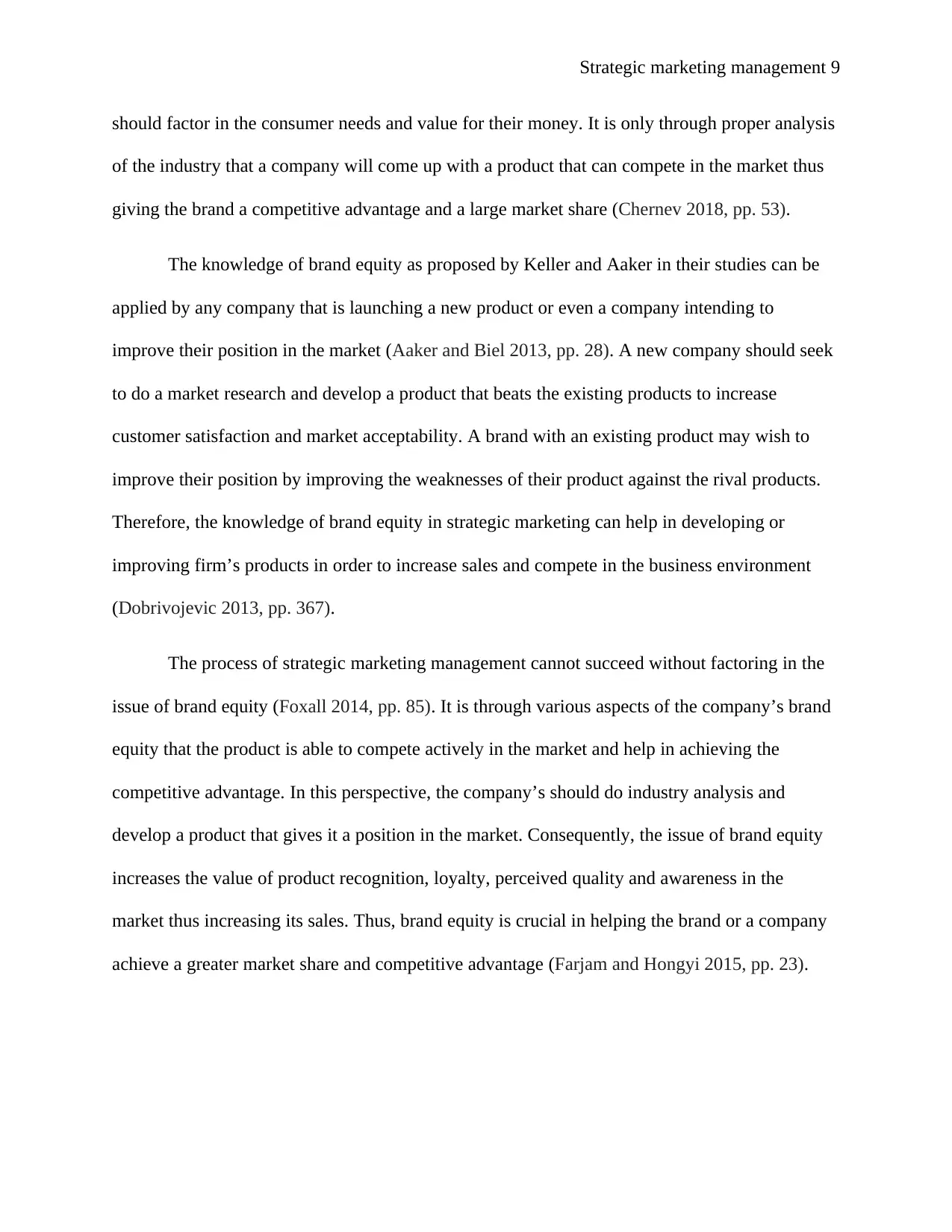
Strategic marketing management 9
should factor in the consumer needs and value for their money. It is only through proper analysis
of the industry that a company will come up with a product that can compete in the market thus
giving the brand a competitive advantage and a large market share (Chernev 2018, pp. 53).
The knowledge of brand equity as proposed by Keller and Aaker in their studies can be
applied by any company that is launching a new product or even a company intending to
improve their position in the market (Aaker and Biel 2013, pp. 28). A new company should seek
to do a market research and develop a product that beats the existing products to increase
customer satisfaction and market acceptability. A brand with an existing product may wish to
improve their position by improving the weaknesses of their product against the rival products.
Therefore, the knowledge of brand equity in strategic marketing can help in developing or
improving firm’s products in order to increase sales and compete in the business environment
(Dobrivojevic 2013, pp. 367).
The process of strategic marketing management cannot succeed without factoring in the
issue of brand equity (Foxall 2014, pp. 85). It is through various aspects of the company’s brand
equity that the product is able to compete actively in the market and help in achieving the
competitive advantage. In this perspective, the company’s should do industry analysis and
develop a product that gives it a position in the market. Consequently, the issue of brand equity
increases the value of product recognition, loyalty, perceived quality and awareness in the
market thus increasing its sales. Thus, brand equity is crucial in helping the brand or a company
achieve a greater market share and competitive advantage (Farjam and Hongyi 2015, pp. 23).
should factor in the consumer needs and value for their money. It is only through proper analysis
of the industry that a company will come up with a product that can compete in the market thus
giving the brand a competitive advantage and a large market share (Chernev 2018, pp. 53).
The knowledge of brand equity as proposed by Keller and Aaker in their studies can be
applied by any company that is launching a new product or even a company intending to
improve their position in the market (Aaker and Biel 2013, pp. 28). A new company should seek
to do a market research and develop a product that beats the existing products to increase
customer satisfaction and market acceptability. A brand with an existing product may wish to
improve their position by improving the weaknesses of their product against the rival products.
Therefore, the knowledge of brand equity in strategic marketing can help in developing or
improving firm’s products in order to increase sales and compete in the business environment
(Dobrivojevic 2013, pp. 367).
The process of strategic marketing management cannot succeed without factoring in the
issue of brand equity (Foxall 2014, pp. 85). It is through various aspects of the company’s brand
equity that the product is able to compete actively in the market and help in achieving the
competitive advantage. In this perspective, the company’s should do industry analysis and
develop a product that gives it a position in the market. Consequently, the issue of brand equity
increases the value of product recognition, loyalty, perceived quality and awareness in the
market thus increasing its sales. Thus, brand equity is crucial in helping the brand or a company
achieve a greater market share and competitive advantage (Farjam and Hongyi 2015, pp. 23).
⊘ This is a preview!⊘
Do you want full access?
Subscribe today to unlock all pages.

Trusted by 1+ million students worldwide
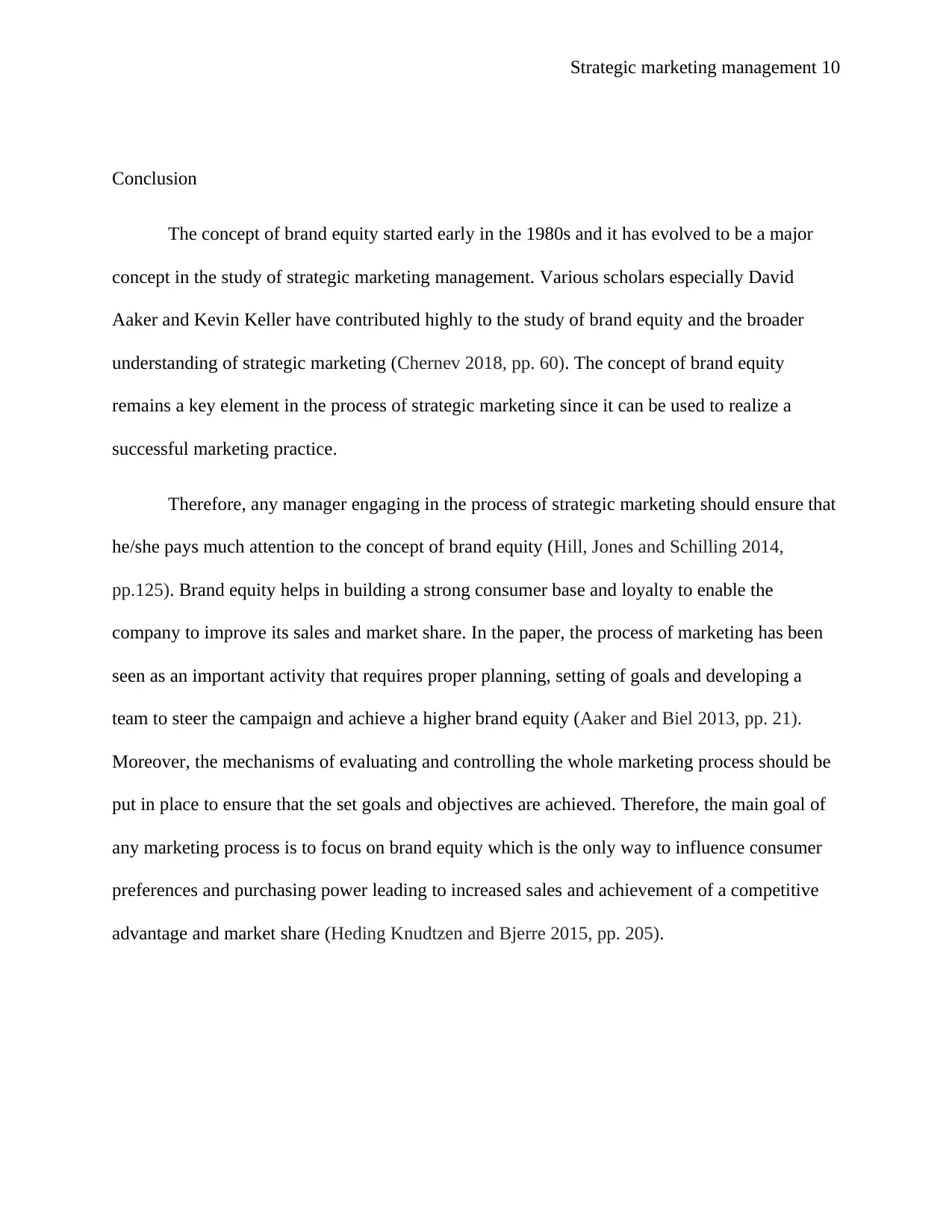
Strategic marketing management 10
Conclusion
The concept of brand equity started early in the 1980s and it has evolved to be a major
concept in the study of strategic marketing management. Various scholars especially David
Aaker and Kevin Keller have contributed highly to the study of brand equity and the broader
understanding of strategic marketing (Chernev 2018, pp. 60). The concept of brand equity
remains a key element in the process of strategic marketing since it can be used to realize a
successful marketing practice.
Therefore, any manager engaging in the process of strategic marketing should ensure that
he/she pays much attention to the concept of brand equity (Hill, Jones and Schilling 2014,
pp.125). Brand equity helps in building a strong consumer base and loyalty to enable the
company to improve its sales and market share. In the paper, the process of marketing has been
seen as an important activity that requires proper planning, setting of goals and developing a
team to steer the campaign and achieve a higher brand equity (Aaker and Biel 2013, pp. 21).
Moreover, the mechanisms of evaluating and controlling the whole marketing process should be
put in place to ensure that the set goals and objectives are achieved. Therefore, the main goal of
any marketing process is to focus on brand equity which is the only way to influence consumer
preferences and purchasing power leading to increased sales and achievement of a competitive
advantage and market share (Heding Knudtzen and Bjerre 2015, pp. 205).
Conclusion
The concept of brand equity started early in the 1980s and it has evolved to be a major
concept in the study of strategic marketing management. Various scholars especially David
Aaker and Kevin Keller have contributed highly to the study of brand equity and the broader
understanding of strategic marketing (Chernev 2018, pp. 60). The concept of brand equity
remains a key element in the process of strategic marketing since it can be used to realize a
successful marketing practice.
Therefore, any manager engaging in the process of strategic marketing should ensure that
he/she pays much attention to the concept of brand equity (Hill, Jones and Schilling 2014,
pp.125). Brand equity helps in building a strong consumer base and loyalty to enable the
company to improve its sales and market share. In the paper, the process of marketing has been
seen as an important activity that requires proper planning, setting of goals and developing a
team to steer the campaign and achieve a higher brand equity (Aaker and Biel 2013, pp. 21).
Moreover, the mechanisms of evaluating and controlling the whole marketing process should be
put in place to ensure that the set goals and objectives are achieved. Therefore, the main goal of
any marketing process is to focus on brand equity which is the only way to influence consumer
preferences and purchasing power leading to increased sales and achievement of a competitive
advantage and market share (Heding Knudtzen and Bjerre 2015, pp. 205).
Paraphrase This Document
Need a fresh take? Get an instant paraphrase of this document with our AI Paraphraser
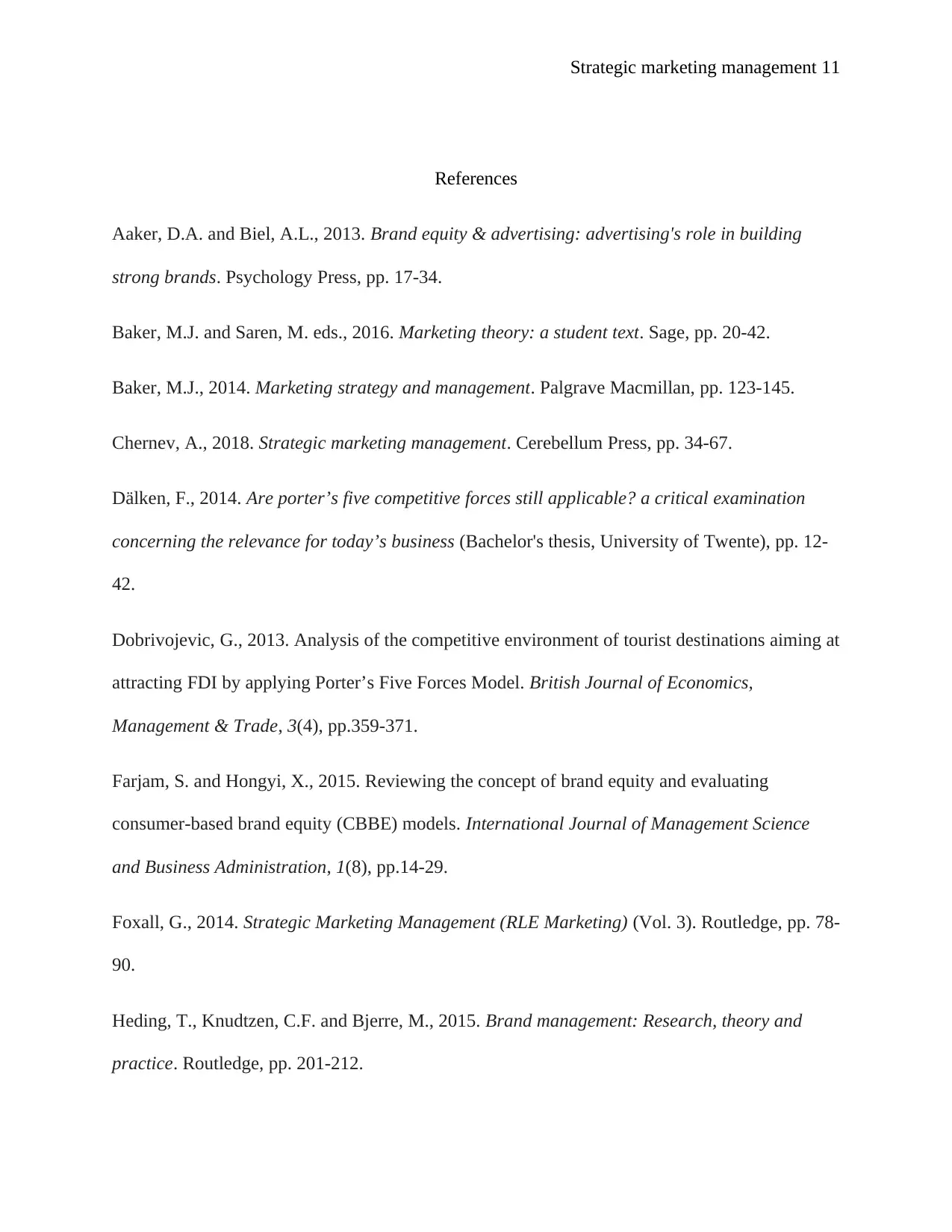
Strategic marketing management 11
References
Aaker, D.A. and Biel, A.L., 2013. Brand equity & advertising: advertising's role in building
strong brands. Psychology Press, pp. 17-34.
Baker, M.J. and Saren, M. eds., 2016. Marketing theory: a student text. Sage, pp. 20-42.
Baker, M.J., 2014. Marketing strategy and management. Palgrave Macmillan, pp. 123-145.
Chernev, A., 2018. Strategic marketing management. Cerebellum Press, pp. 34-67.
Dälken, F., 2014. Are porter’s five competitive forces still applicable? a critical examination
concerning the relevance for today’s business (Bachelor's thesis, University of Twente), pp. 12-
42.
Dobrivojevic, G., 2013. Analysis of the competitive environment of tourist destinations aiming at
attracting FDI by applying Porter’s Five Forces Model. British Journal of Economics,
Management & Trade, 3(4), pp.359-371.
Farjam, S. and Hongyi, X., 2015. Reviewing the concept of brand equity and evaluating
consumer-based brand equity (CBBE) models. International Journal of Management Science
and Business Administration, 1(8), pp.14-29.
Foxall, G., 2014. Strategic Marketing Management (RLE Marketing) (Vol. 3). Routledge, pp. 78-
90.
Heding, T., Knudtzen, C.F. and Bjerre, M., 2015. Brand management: Research, theory and
practice. Routledge, pp. 201-212.
References
Aaker, D.A. and Biel, A.L., 2013. Brand equity & advertising: advertising's role in building
strong brands. Psychology Press, pp. 17-34.
Baker, M.J. and Saren, M. eds., 2016. Marketing theory: a student text. Sage, pp. 20-42.
Baker, M.J., 2014. Marketing strategy and management. Palgrave Macmillan, pp. 123-145.
Chernev, A., 2018. Strategic marketing management. Cerebellum Press, pp. 34-67.
Dälken, F., 2014. Are porter’s five competitive forces still applicable? a critical examination
concerning the relevance for today’s business (Bachelor's thesis, University of Twente), pp. 12-
42.
Dobrivojevic, G., 2013. Analysis of the competitive environment of tourist destinations aiming at
attracting FDI by applying Porter’s Five Forces Model. British Journal of Economics,
Management & Trade, 3(4), pp.359-371.
Farjam, S. and Hongyi, X., 2015. Reviewing the concept of brand equity and evaluating
consumer-based brand equity (CBBE) models. International Journal of Management Science
and Business Administration, 1(8), pp.14-29.
Foxall, G., 2014. Strategic Marketing Management (RLE Marketing) (Vol. 3). Routledge, pp. 78-
90.
Heding, T., Knudtzen, C.F. and Bjerre, M., 2015. Brand management: Research, theory and
practice. Routledge, pp. 201-212.
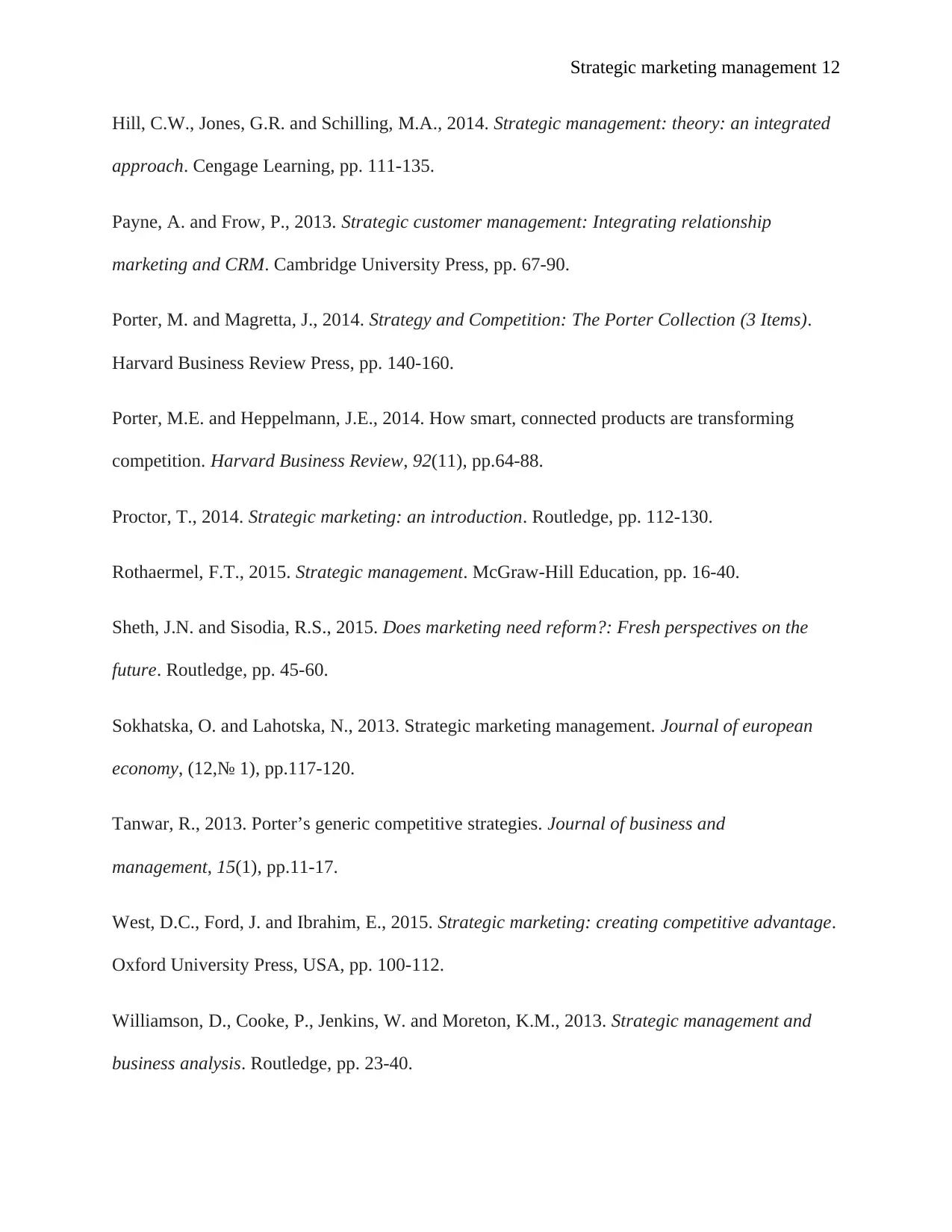
Strategic marketing management 12
Hill, C.W., Jones, G.R. and Schilling, M.A., 2014. Strategic management: theory: an integrated
approach. Cengage Learning, pp. 111-135.
Payne, A. and Frow, P., 2013. Strategic customer management: Integrating relationship
marketing and CRM. Cambridge University Press, pp. 67-90.
Porter, M. and Magretta, J., 2014. Strategy and Competition: The Porter Collection (3 Items).
Harvard Business Review Press, pp. 140-160.
Porter, M.E. and Heppelmann, J.E., 2014. How smart, connected products are transforming
competition. Harvard Business Review, 92(11), pp.64-88.
Proctor, T., 2014. Strategic marketing: an introduction. Routledge, pp. 112-130.
Rothaermel, F.T., 2015. Strategic management. McGraw-Hill Education, pp. 16-40.
Sheth, J.N. and Sisodia, R.S., 2015. Does marketing need reform?: Fresh perspectives on the
future. Routledge, pp. 45-60.
Sokhatska, O. and Lahotska, N., 2013. Strategic marketing management. Journal of european
economy, (12,№ 1), pp.117-120.
Tanwar, R., 2013. Porter’s generic competitive strategies. Journal of business and
management, 15(1), pp.11-17.
West, D.C., Ford, J. and Ibrahim, E., 2015. Strategic marketing: creating competitive advantage.
Oxford University Press, USA, pp. 100-112.
Williamson, D., Cooke, P., Jenkins, W. and Moreton, K.M., 2013. Strategic management and
business analysis. Routledge, pp. 23-40.
Hill, C.W., Jones, G.R. and Schilling, M.A., 2014. Strategic management: theory: an integrated
approach. Cengage Learning, pp. 111-135.
Payne, A. and Frow, P., 2013. Strategic customer management: Integrating relationship
marketing and CRM. Cambridge University Press, pp. 67-90.
Porter, M. and Magretta, J., 2014. Strategy and Competition: The Porter Collection (3 Items).
Harvard Business Review Press, pp. 140-160.
Porter, M.E. and Heppelmann, J.E., 2014. How smart, connected products are transforming
competition. Harvard Business Review, 92(11), pp.64-88.
Proctor, T., 2014. Strategic marketing: an introduction. Routledge, pp. 112-130.
Rothaermel, F.T., 2015. Strategic management. McGraw-Hill Education, pp. 16-40.
Sheth, J.N. and Sisodia, R.S., 2015. Does marketing need reform?: Fresh perspectives on the
future. Routledge, pp. 45-60.
Sokhatska, O. and Lahotska, N., 2013. Strategic marketing management. Journal of european
economy, (12,№ 1), pp.117-120.
Tanwar, R., 2013. Porter’s generic competitive strategies. Journal of business and
management, 15(1), pp.11-17.
West, D.C., Ford, J. and Ibrahim, E., 2015. Strategic marketing: creating competitive advantage.
Oxford University Press, USA, pp. 100-112.
Williamson, D., Cooke, P., Jenkins, W. and Moreton, K.M., 2013. Strategic management and
business analysis. Routledge, pp. 23-40.
⊘ This is a preview!⊘
Do you want full access?
Subscribe today to unlock all pages.

Trusted by 1+ million students worldwide
1 out of 13
Related Documents
Your All-in-One AI-Powered Toolkit for Academic Success.
+13062052269
info@desklib.com
Available 24*7 on WhatsApp / Email
![[object Object]](/_next/static/media/star-bottom.7253800d.svg)
Unlock your academic potential
Copyright © 2020–2025 A2Z Services. All Rights Reserved. Developed and managed by ZUCOL.




